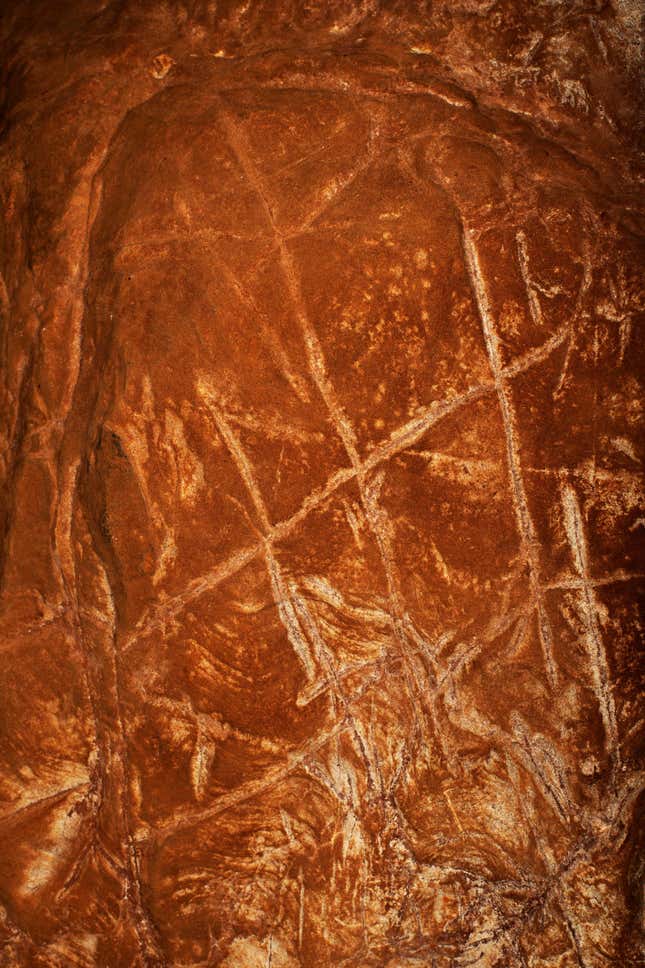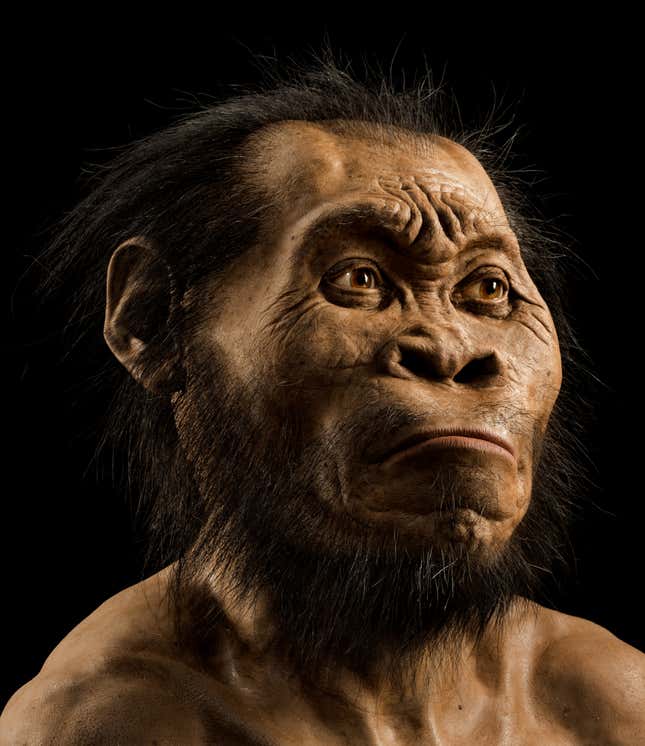Ancient Human Relative Buried Its Dead Long Before Us
A team of paleoanthropologists has discovered evidence that the extinct human relative Homo naledi not only intentionally buried their dead, but also used symbols, perhaps for mortuary reasons.
The evidence—found in the extensive Rising Star cave system in South Africa where the species was first identified 10 years ago—precedes the oldest known ceremonial burials of Homo sapiens by 100,000 years. Of course, older deliberate burials by Homo sapiens could well be discovered in the future, but that’s the timestamp we currently have to work with.
Other hominin species—most notably Neanderthals—also buried their dead, but the superlative age of the Homo naledi burials is sure to turn heads.
Homo naledi had human-like teeth, a body built for climbing, and a small brain, clocking in at about one-third the size of our brains. The remains in the Rising Star system cover a wide age range from the species (including children as well as older individuals), giving researchers a unique look into the entire population.
The team’s research papers are set to publish in eLife (and are currently hosted on the preprint server BioRxiv), and members of the research team discussed the findings at a press conference last week.
“These recent findings suggest intentional burials, the use of symbols, and meaning-making activities by Homo naledi. It seems an inevitable conclusion that in combination they indicate that this small-brained species of ancient human relatives was performing complex practices related to death,” said Lee Berger, a paleoanthropologist at the University of the Witwatersrand in South Africa, the Carnegie Institution for Science, and the National Geographic Society, in a society release. “That would mean not only are humans not unique in the development of symbolic practices, but may not have even invented such behaviors.”

Three research papers were produced to describe the new findings; one paper details the symbological rock carvings made by Homo naledi on the cave walls, a second describes the evidence for deliberate burials by the species, and a third explores the burials and engravings in an evolutionary context, that is, a summation of what these findings mean for our understanding of behavior and cognitive evolution in hominins.
The Homo naledi fossils were found in multiple chambers of the Rising Star system, which extends at least 984 feet (300 meters) underground. Some chambers in the cave are difficult to access, excavator Keneiloe Molopyane said in the press conference. This would have been the case even when H. naledi was laying its dead to rest, Berger added, a point that has been controversial since the fossils’ discovery.
The burials consist of holes dug in the cave, in which remains were curled into fetal positions, Berger said. By the team’s assessment, there is no evidence of fluvial (that is, watery) activity in the cave that could have washed out the holes. They were made by hominins and have been preserved for hundreds of thousands of years, the team argues.

The engraved symbols date to between 241,000 and 335,000 years old, but more testing will be done to get a more specific timeframe on when they were made. They are cross-hatch patterns and geometric shapes, evidently carved into the cave walls by sharp instruments. The dating of engraved symbols is notoriously difficult, so these dates should be viewed with some caution.
Augustín Fuentes, a co-author of the research and a biocultural specialist at the University of the Witwatersrand and Princeton University, said in the press conference that “what is unexpected and what’s very prominent about these discoveries is that here, for the first time, we’re showing that a non-Homo sapiens, member of the genus homo or hominin, is engaging in clear behavior that we associate with more complex and particularly larger brained organisms.”
It’s been a decade since scientists first discovered Homo naledi in the Rising Star system, and the latest discovery is throwing a wrench at what we thought about how hominins treated their dead.
It’ll be interesting to first know more specifically when the rock carvings were made, but for paleoanthropologists, its an exciting opportunity to consider what “human” really is, and how much of what we consider unique to our own species has been done by others in the ancient past.
More: Move Over Neanderthals, Newly Discovered ‘Dragon Man’ Might Be Our True Sister Species
A team of paleoanthropologists has discovered evidence that the extinct human relative Homo naledi not only intentionally buried their dead, but also used symbols, perhaps for mortuary reasons.
The evidence—found in the extensive Rising Star cave system in South Africa where the species was first identified 10 years ago—precedes the oldest known ceremonial burials of Homo sapiens by 100,000 years. Of course, older deliberate burials by Homo sapiens could well be discovered in the future, but that’s the timestamp we currently have to work with.
Other hominin species—most notably Neanderthals—also buried their dead, but the superlative age of the Homo naledi burials is sure to turn heads.

Homo naledi had human-like teeth, a body built for climbing, and a small brain, clocking in at about one-third the size of our brains. The remains in the Rising Star system cover a wide age range from the species (including children as well as older individuals), giving researchers a unique look into the entire population.
The team’s research papers are set to publish in eLife (and are currently hosted on the preprint server BioRxiv), and members of the research team discussed the findings at a press conference last week.
“These recent findings suggest intentional burials, the use of symbols, and meaning-making activities by Homo naledi. It seems an inevitable conclusion that in combination they indicate that this small-brained species of ancient human relatives was performing complex practices related to death,” said Lee Berger, a paleoanthropologist at the University of the Witwatersrand in South Africa, the Carnegie Institution for Science, and the National Geographic Society, in a society release. “That would mean not only are humans not unique in the development of symbolic practices, but may not have even invented such behaviors.”

Three research papers were produced to describe the new findings; one paper details the symbological rock carvings made by Homo naledi on the cave walls, a second describes the evidence for deliberate burials by the species, and a third explores the burials and engravings in an evolutionary context, that is, a summation of what these findings mean for our understanding of behavior and cognitive evolution in hominins.
The Homo naledi fossils were found in multiple chambers of the Rising Star system, which extends at least 984 feet (300 meters) underground. Some chambers in the cave are difficult to access, excavator Keneiloe Molopyane said in the press conference. This would have been the case even when H. naledi was laying its dead to rest, Berger added, a point that has been controversial since the fossils’ discovery.
The burials consist of holes dug in the cave, in which remains were curled into fetal positions, Berger said. By the team’s assessment, there is no evidence of fluvial (that is, watery) activity in the cave that could have washed out the holes. They were made by hominins and have been preserved for hundreds of thousands of years, the team argues.

The engraved symbols date to between 241,000 and 335,000 years old, but more testing will be done to get a more specific timeframe on when they were made. They are cross-hatch patterns and geometric shapes, evidently carved into the cave walls by sharp instruments. The dating of engraved symbols is notoriously difficult, so these dates should be viewed with some caution.
Augustín Fuentes, a co-author of the research and a biocultural specialist at the University of the Witwatersrand and Princeton University, said in the press conference that “what is unexpected and what’s very prominent about these discoveries is that here, for the first time, we’re showing that a non-Homo sapiens, member of the genus homo or hominin, is engaging in clear behavior that we associate with more complex and particularly larger brained organisms.”
It’s been a decade since scientists first discovered Homo naledi in the Rising Star system, and the latest discovery is throwing a wrench at what we thought about how hominins treated their dead.
It’ll be interesting to first know more specifically when the rock carvings were made, but for paleoanthropologists, its an exciting opportunity to consider what “human” really is, and how much of what we consider unique to our own species has been done by others in the ancient past.
More: Move Over Neanderthals, Newly Discovered ‘Dragon Man’ Might Be Our True Sister Species
